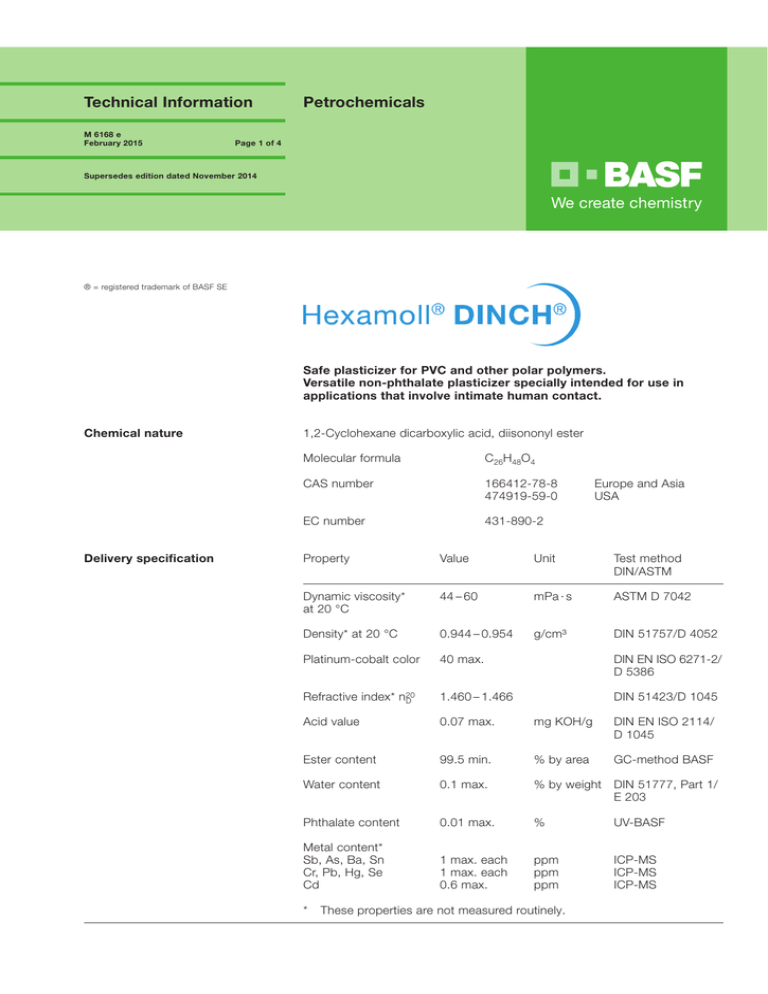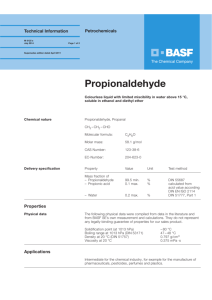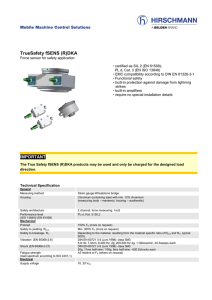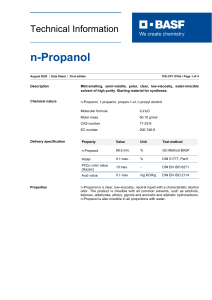Petrochemicals Technical Information
advertisement

Technical Information M 6168 e February 2015 Petrochemicals Page 1 of 4 Supersedes edition dated November 2014 ® = r egistered trademark of BASF SE Safe plasticizer for PVC and other polar polymers. Versatile non-phthalate plasticizer specially intended for use in applications that involve intimate human contact. Chemical nature 1,2-Cyclohexane dicarboxylic acid, diisononyl ester Molecular formula C26H48O4 CAS number 166412-78-8 Europe and Asia 474919-59-0USA 431-890-2 EC number Delivery specification Property Value Unit Test method DIN/ASTM Dynamic viscosity* at 20 °C 44 – 60 mPa · s ASTM D 7042 Density* at 20 °C 0.944 – 0.954 g/cm³ DIN 51757/D 4052 Platinum-cobalt color 40 max. Refractive index* n20 D 1.460 – 1.466 DIN EN ISO 6271-2/ D 5386 DIN 51423/D 1045 Acid value 0.07 max. mg KOH/g DIN EN ISO 2114/ D 1045 GC-method BASF Ester content 99.5 min. % by area Water content 0.1 max. % by weight DIN 51777, Part 1/ E 203 Phthalate content 0.01 max. % UV-BASF Metal content* Sb, As, Ba, Sn Cr, Pb, Hg, Se Cd 1 max. each 1 max. each 0.6 max. ppm ppm ppm ICP-MS ICP-MS ICP-MS *** These properties are not measured routinely. M 6168 e February 2015 Page 2 of 4 Hexamoll DINCH Properties Hexamoll DINCH is a colorless, clear and practically anhydrous liquid with a hardly noticeable odor. It is soluble in the usual organic solvents and is miscible and compatible with all of the monomeric plasticizers commonly used in PVC. Hexamoll DINCH is almost insoluble in water. Hexamoll DINCH is listed for use in food-contact and medical applications. Information on its regulatory status according to food-contact or medical legislation is available in a separate document that we would be pleased to send you on request. Physical dataThe following physical data were measured in the BASF SE laboratories. They do not represent any legally-binding guarantee of properties for our sales product. Molar mass Pour point (DIN ISO 3016) 424.7 g/mol – 54 °C Solution temperature at the clear point (5 % S-PVC; K-value 71; DIN 53408) Surface tension at 20 °C (DIN EN 14370) 30.7 mN/m Saponification value (DIN EN ISO 3681) 264 mgKOH/g T [°C] Vapor pressure 151 ºC p [hPa] 50 1.3 · 10 -6 60 5.5 · 10 -6 70 2.2 · 10 -5 80 7.5 · 10 -5 90 2.3 · 10 -4 100 6.7 · 10 -4 120 4.4 · 10 -3 140 2.2 · 10 -2 160 0.09 180 0.31 200 0.95 220 2.6 240 6.2 26013.9 27020.2 Antoine constants for (p in bar; T in °C) ln (p) = A + B / (C + T) A = 11.6057 B = – 6601.25 C = 155.61 (The Antoine constants were determined from vapor pressure data measured in the temperature range of 190 °C to 270 °C by a dynamic method in a nitrogen atmosphere. The values in the table were calculated using the Antoine equation. The data serve only as a rough guide.) M 6168 e February 2015 Page 3 of 4 Density and viscosity Temperature [°C] – 25 – 10 0 5 10 20 30 40 50 Hexamoll DINCH Density* [g/cm³] Dyn. viscosity [mPa · s] 0.9796 2000 0.9691 430 0.9621 187 0.9586 135.1 0.9551 95.5 0.9481 52.0 0.9411 30.1 0.9341 19.3 0.9271 13.1 ** C alculated using the following equation: = (– 0.0007t + 0.9621) from data measured by BASF SE. ( = Density in g/cm³, t = Temperature in °C) Specific heat CP (DSC) according to DIN 51007 Temperatur [°C] Specific heat CP [J/(g ∙ K)] 30 1.81 45 1.88 60 1.94 90 2.06 1052.10 1202.14 1352.18 1502.20 Net and gross calorific value Net calorific Gross calorific value Hu [MJ/Kg] value Ho [MJ/Kg] 34.5 Measured according to ISO 1716 Volume resistivity 20 °C (IEC 60093) 37.0 1.5 ∙ 1013 Ohm ∙ cm Storage & Handling Hexamoll DINCH can be stored in tanks and drums constructed from normal carbon steel, e. g. A 283 grade. If severe demands are imposed on the product quality, we recommend that it be stored in tanks constructed from stainless steel, e. g. AISI TP 316 Ti (German steel No. 1.4541) or aluminium (AlMg3). It is recommended that steps be taken to ensure the exclusion of atmospheric moisture, e. g. by storing under a blanket of dry nitrogen, as otherwise the product quality may deteriorate, e. g. the water fraction may rise, or the Hexamoll DINCH may be discolored by rust in normal steel tanks. Drums containing the product should be kept tightly closed in a wellventilated place. Hexamoll DINCH can be stored for one year in its original packaging at temperatures below 40 °C, if moisture is excluded. Only dedicated equipment should be used to discharge this product. M 6168 e February 2015 Page 4 of 4 Hexamoll DINCH Pumps: Cast-steel centrifugal pumps with a simple slip-ring seal are suitable. Flange seals: An example of a suitable material for seals is chemical-resistant Polytetrafluoroethylene (PTFE). Other plastics should be checked for suitability before they are taken into use. Safety When using this product, the information and advice given in our Safety Data Sheet should be observed. Due attention should also be given to the precautions necessary for handling chemicals. Note The data contained in this publication are based on our current knowledge and experience. In view of the many factors that may affect processing and application of our product, these data do not relieve processors from carrying out their own investigations and tests; neither do these data imply any guarantee of certain properties, nor the suitability of the product for a specific purpose. Any descriptions, drawings, photographs, data, proportions, weights etc. given herein may change without prior information and do not constitute the agreed contractual quality of the product. It is the responsibility of the recipient of our products to ensure that any proprietary rights and existing laws and legislation are observed. February 2015 BASF SE Operating Division Petrochemicals Regional Business Unit Industrial Petrochemicals Europe 67056 Ludwigshafen, Germany Visit us on-line at http://www.hexamoll-dinch.com



